Colin Abrey of Nextivity explains why the NHS digital transformation will be neither feasible nor achievable in the long term without a mobile connectivity overhaul
The universal problem of unreliable cellular coverage has far-reaching implications for business and individuals.
And nowhere is this more apparent than in healthcare.
Ubiquitous mobile connectivity is not only essential for day-to-day logistics and first-responder communications, but seamless mobile coverage will be the technology underpinning the success of the NHS’s digitised future.
Ubiquitous mobile connectivity is not only essential for day-to-day logistics and first-responder communications, but seamless mobile coverage will be the technology underpinning the success of the NHS’s digitised future
When the NHS initially published its Long-term Digital Transformation Plan, it outlined how technology could be used to improve performance targets, reduce waiting times, streamline routine processes, and deliver higher standards of patient care.
In tandem, the NHS has also pledged to adopt a mobile-first strategy so it can truly harness the power of smartphones and tablets to improve health and social care services, particularly as pagers and DECT phones are slowly being phased out.
While the NHS has truly embraced the power of technology over the last few months, and has launched an abundance of digitised services such as virtual consultations, virtual ward rounds, digitised prescription processing, and a range of health wellbeing Apps in response to COVID-19; what has become increasingly apparent are the huge gaps in the associated ICT infrastructures needed for the smooth running of these new online services.
This holds particularly true for mobile communications, which is not only essential for day-to-day communications, but is fundamental to first-responder communications, to the quick mobilisation of in-the-field teams, and is continuously used by paramedics and other 999 services.
In our digitised society driven by all things IoT, a reliable mobile coverage inside any building, regardless of its size or type, along with high-speed access to the internet should be a given.
Ensuring seamless mobile coverage in sprawling hospital facilities isn’t a straightforward process due to their complex layouts and the sheer number of internal corridors, clinics, wards, stairwells and basement areas, all of which are notorious mobile blackspots
However, ensuring seamless mobile coverage in sprawling hospital facilities isn’t a straightforward process due to their complex layouts and the sheer number of internal corridors, clinics, wards, stairwells and basement areas, all of which are notorious mobile blackspots.
This is without taking into account the different building materials; metal, glass, reinforced concrete etc used in the first place, all of which hamper the transmission of mobile phone signals.
Ensuring seamless coverage is particularly challenging in subterranean locations, which are typically home to CCTV control rooms, A&E admissions, operating theatres, and ambulance bays.
These underground areas, more often than not, have the worst mobile coverage levels.
In contrast, the use of smartphones, and indeed other wireless devices in these very same locations, is fundamental to safety-critical communications between the different teams involved.
Ensuring ubiquitous mobile coverage in a hospital’s emergency and stabilisation facilities, regardless of the provider, should by default form part of its critical communications infrastructure.
In reality, however, ensuring seamless connectivity in basement areas and other challenging locations is often overlooked.
If a hospital does not have adequate coverage throughout the building, including basement locations, first-response teams won’t be able to effectively co-ordinate an emergency situation
Seamless mobile connectivity is not just limited to regular comms and to power digitised service either. It’s set to become the enabling technology to public safety communications as the UK presses on with plans to replace its legacy TETRA network with 4G over the next two years.
Referred to as the Emergency Services Network (ESN), this new public safety communications network will allow paramedics, police, and fire services to leverage digital applications such as live video feeds, location-based services, or wearable tech so they can better respond to emergency situations.
On the downside, however, if a hospital does not have adequate coverage throughout the building, including basement locations, first-response teams won’t be able to effectively co-ordinate an emergency situation.
Once the new network has gone mainstream, the only way to guarantee the levels of voice and data coverage needed is to take the outside signal indoors using supplementary signal boosting equipment.
This hasn’t always been straightforward, either, because of the high costs involved, lengthy deployment times, and strict rules governing their usage.
Fortunately, this is no longer the case, thanks to relaxation to the mobile repeater rules for in-building usage.
Following years of warnings that the NHS is becoming less and less able to cope with even routine demands; the current health crisis could be the driving force needed to trigger a change
The caveat is that any installed equipment must satisfy the regulator’s mobile repeater licence exemption spec and not many do.
A trigger for change
Healthcare organisations are long overdue a technological overhaul, but this has been held back by a myriad of factors, including implementation cost, existing infrastructure, and legacy systems and technologies.
Following years of warnings that the NHS is becoming less and less able to cope with even routine demands; the current health crisis could be the driving force needed to trigger a change.Sign up for your free email newsletter
Not only does it provide the perfect opportunity to ensure that all hospital buildings are ESN-ready; but uninterrupted mobile connectivity is central to the adoption of next-generation technologies that will be the make or break of the NHS’s digitised future.
A version of this article was originally published by BBH (Building Better Healthcare)




